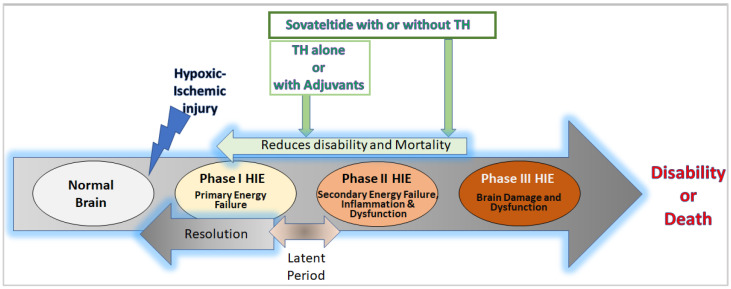Figure 1.
Diagrammatic representation of the phases of hypoxic-ischemic encephalopathy (HIE). After hypoxic-ischemic injury in the normal neonatal brain (white), phase I of HIE (yellow) includes primary energy failure in the neural tissue. The phase I energy failure has a latent period (bi-directional arrow) ranging from 6 h to 15 h (depending upon the severity of the injury), which is a transition period with chances of resolving the issue of primary energy failure due to restoration of blood flow by alternative reperfusion events in the body. Hence, the latent period is also considered the best time for starting a therapy or intervention for treating HIE. If the primary energy failure is unresolved, it leads to phase II of HIE (light orange) with secondary energy failure, overwhelming inflammation, and neural dysfunction. The phase II HIE events are highly devastating and could lead to the phase III HIE (orange) with damaged brain tissue and brain dysfunction, which cause disability or death in HIE patients. At cellular and molecular levels, the primary phase of HIE involves ATP deprivation, abnormal calcium influx, excitotoxicity, and necrosis in neurovascular cells. The secondary phase is marked with oxidative stress following reperfusion, microglial activation, inflammation, excitotoxicity, and cell death (apoptosis/necrosis). The tertiary phase is characterized by decreased neural cell plasticity and a reduced number of neurons (not shown in the diagram). Currently, available interventions for HIE, e.g., TH and adjuvants, are known to act during the latent period (green arrow) and help in reducing the severity of secondary energy failure and would decrease brain damage and dysfunction. However, no evidence of regeneration or repair in the ischemic/hypoxic damaged neural tissue has been reported after treatment with TH and adjuvants. On the other hand, sovateltide (green arrows) has demonstrated mitigation of secondary energy failure and enhancement of neuronal regeneration and repair in the ischemic/hypoxic brain of the HIE rat model and the ischemic stroked brain of the rat and human. Therefore, we anticipate that sovateltide could be developed as a new “First in Class” therapeutic or adjuvant to TH for treating HIE.

